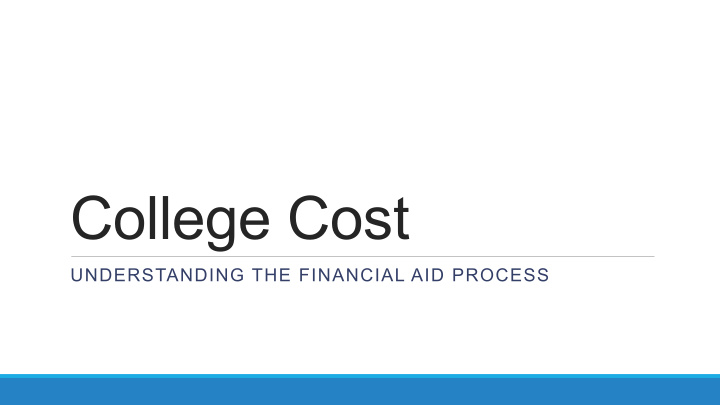



College Cost UNDERSTANDING THE FINANCIAL AID PROCESS
Agenda History and Philosophy of Federal Financial Aid Programs College Choice Forms, Formulas and Assessing Family Financial Strength Completing the FAFSA Types of Aid Resources
History and Philosophy Students and their family(ies) have the primary responsibility to pay for college. Sacrifice is assumed. Financial aid assessment is NOT a cash flow analysis but rather an evaluation of an individual family’s economic strength. The contribution is determined by a standard formula that assesses a family’s ability to pay. Willingness is not a factor.
History and Philosophy Savings Current Income Loans
Financial aid helps bridge the gap between the cost of education and what the family can pay.
College Choice must be Rational College or University in everyone’s price range Don’t be distracted by brand names Fit Academic, Social and Financial
Forms, Formulas and Assessing Financial Strength Forms ◦ FAFSA ◦ Free ◦ Required at all Schools ◦ Perceived difficulty ◦ CSS Profile ◦ Fee and Fee Waivers ◦ Utilized to award Institutional Aid at more selective private institutions ◦ Institutional Form
Formula Process for assessing a family’s ability to contribute toward post secondary education is called: Needs Analysis Begins with completing the FAFSA Results in an EFC ◦ Eligibility Index ◦ Rationing tool ◦ Family Share
EFC Income Assets Family Size Age of the Older Parent Number of Dependent Children enrolled in College
Determining Financial Need Aid is awarded on the full cost of attendance: ◦ Tuition* ◦ Room and Meals* ◦ Fees* ◦ Books and Supplies ◦ Travel to School ◦ Personal and Miscellaneous expenses *Direct Cost typically paid to the college or university
Determining Financial Need Expected Family Total Cost of Contribution Financial Need Attendance (EFC)
Examples of Financial Need Public College Private College Cost $ 25,290 Cost $50,900 EFC -$10,000 EFC -$10,000 Need $ 15,290 Need $40,900 Source: The College Board Average Estimated Budgets, 2017-18
Completing the FAFSA To complete the FAFSA you will need to: Apply for a FSA ID Email addresses associated with FSA ID accounts must be unique. Parent(s) must have his/her own FSA ID. FSA ID serves as electronic signatures for the FAFSA and promissory notes fsaid.ed.gov
Completing the FAFSA Gather your and your parent’s 2018 Federal tax information The FAFSA is student specific. Select the appropriate school year Complete all sections about you, your school plans and the financial information (use the IRS Data Retrieval Tool). List your school code(s). You may list up to 10 schools on the electronic FAFSA. Provide electronic signatures (FSA IDs) Submit your information Keep copies for your records www.FAFSA.gov
Completing the FAFSA Points to Remember: The earliest you may file the FAFSA for the 2020-2021 school year October 1, 2019. Check with the colleges where you plan to apply for deadlines and institutional requirements Link to the IRS data Retrieval Tool Common errors: Forgetting to report untaxed income – payments to tax deferred pensions and retirement savings plans and untaxed portions of health savings accounts Child Support rec eived Your student must re-apply for aid every year. Dependency Status Who is considered a parent?
Completing the FAFSA Here’s what happens after you file: Your EFC is calculated Results are sent electronically to the college(s) you selected. You will receive a Student Aid Report (SAR). If you have extraordinary circumstances notify the Financial Aid Office. After you are admitted to a college, a financial aid award will be sent to you. You may be required to verify the information submitted on your FAFSA Using the IRS Data Retrieval Tool will simplify the process Non-Tax Filers must provide W-2s and IRS Verification of non-filing (Does not apply to Dependent Students)
Types of Aid Gift Aid Scholarships Grants Self Help Student Employment Loans
Scholarships Merit-based Academic Talent Athletic Service ROTC Private: Fastweb fastweb.com/ BigFuture bigfuture.collegeboard.org/scholarship-search
Grants Need-based Federal Grants Pell SEOG TEACH State Grants Wisconsin Grant Institutional Grants
Employment Two Types: Federal Work Study Regular Campus Employment Can be used for personal expenses Does not adversely affect grades
Student Loans Federal Stafford Subsidized Unsubsidized (anyone can borrow) Freshmen - $3500 Sophomores - $4500 Juniors/Seniors - $5500 Additional Unsub $2000/year 6 month Grace Period 10 year Standard Repayment
Other Options Parent PLUS Loan Student Alternative Loans – Private Lenders Private Scholarships Must be reported to the school Payment Plan Tax Credits 529 Plans
Resources Net Price Calculators Early Financial Aid Estimation Tool On every College Website Cost –Grants & Scholarships = Net Price Websites General Information studentaid.ed.gov consumerfinance.gov/paying-for-college bigfuture.collegeboard.org
Resources Websites cont. College Cost Comparison Tools nces.ed.gov/collegenavigator/ bigfuture.collegeboard.org/compare-colleges consumerfinance.gov/paying-for-college/compare-financial-aid-and-college-cost/ Award Letter Comparison Tools bigfuture.collegeboard.org/pay-for-college/financial-aid-awards/compare-aid- calculator
Resources Websites Cont. Scholarship Search Engines fastweb.com bigfuture.collegeboard.org/scholarship-search College Goal Wisconsin 45 scheduled events around the state October 2, 7, 9,14,16, 17, 21, 23, 28 & 30, 2019 November 4 & 6, 2019 Free assistance with completing the paper or on-line FAFSA collegegoalwi.org
Additional Information Marquette University Office of Student Financial Aid 414.288.4000 marquettecentral@marquette.edu Website: www.marquette.edu/mucentral
Recommend
More recommend